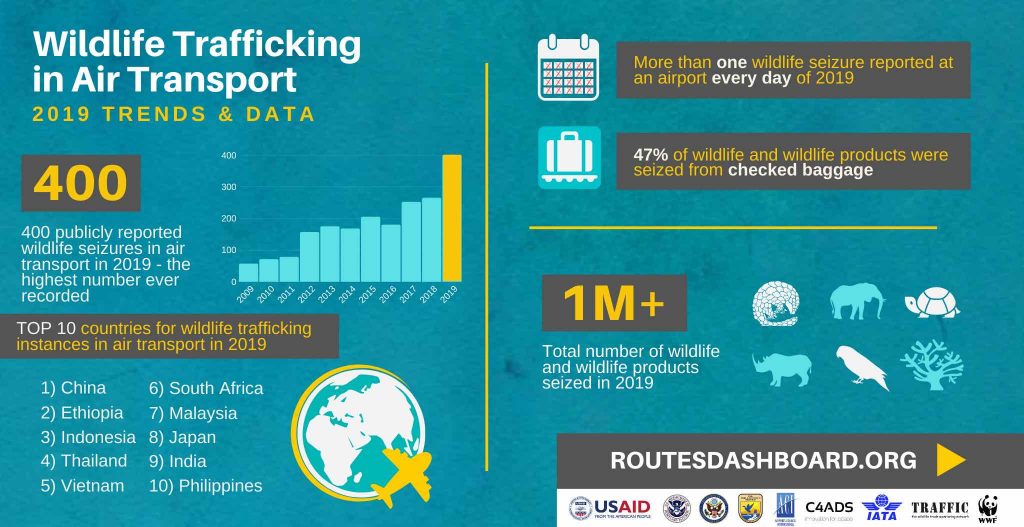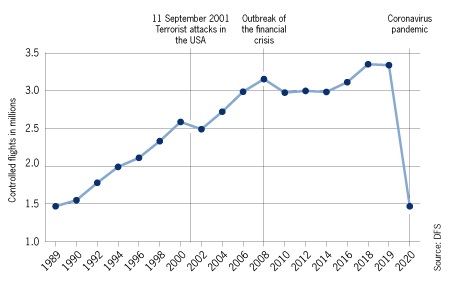Last year, more than one million illegal wildlife products and live animals were seized from wildlife traffickers at airports

A new analysis of wildlife trafficking seizures in air transport reveals the illegal wildlife trade to be truly global in scope, encompassing additional airport locations as each year goes by.
The report, Runway to Extinction: Wildlife Trafficking in the Air Transport Sector, produced by C4ADS as part of the USAID Reducing Opportunities for Unlawful Transport of Endangered Species (ROUTES) Partnership, details how traffickers operating in every populated region of the world rely on similar trafficking methods and utilize the same vulnerabilities within the air transport sector as traffickers of other illicit goods.
Runway to Extinction examines the trends, transit routes, and trafficking methods used by wildlife smugglers exploiting the aviation industry in six world regions: Africa, the Americas, Asia, Europe, the Middle East, and Oceania.
The information in the report is complemented by the ROUTES Dashboard, which enables visitors to filter and view information on wildlife trafficking incidents in the air transport sector over the past ten years.
The report’s author, Mary Utermohlen, Program Director at C4ADS, said: “This report highlights the widespread, pervasive nature of wildlife trafficking by air, with each major world region impacted. Our analysis shows that traffickers of all types exploit the same vulnerabilities within airports, often using the same trafficking methods to circumvent law enforcement and airport authorities.
“Furthermore, seizure data shows that many wildlife trafficking networks rely on the same smuggling methods over time, suggesting that a thorough understanding of airport-specific or country-specific trafficking patterns could be instrumental in reducing the air transport system’s vulnerability to trafficking.”
In addition to contributing to the extinction of endangered species, threatening local livelihoods, and undermining regional and global security, illegal wildlife trade is a risk factor for the spread of zoonotic diseases. According to the Center for Disease Control, three out of every four new or emerging infectious diseases originate in animals.
Many of the species seized in air transport—including live birds, live reptiles and mammals—are high-risk carriers of zoonotic diseases and may end up in illegal or unregulated markets around the world.
Michelle Owen, ROUTES Lead said: “Faced with the current health crisis caused by the novel Covid-19 virus, the world is unfortunately grappling with the danger and economic turmoil that zoonotic diseases can pose. Trafficked wildlife present particular risks in this context.
“By training staff to detect and report wildlife trafficking and working with enforcement agencies to intercept wildlife traffickers, airports and airlines can help strengthen their operations and can play a role in reducing the risk of future outbreaks.”
Jon Godson, Assistant Director of Environment at the International Air Transport Association (IATA), said: “Many airlines recognize the need to combat wildlife trafficking and are stepping up as leaders in this global effort. Airline staff spend more time with passengers and baggage than customs authorities and can provide a key source of intelligence for enforcement agencies.
“Also, the rapid introduction of new technology in the sector presents an opportunity for public-private partnerships based on the smarter use of digital intelligence to apprehend wildlife traffickers.”
Juliana Scavuzzi, Senior Manager of Environment at Airports Council International (ACI) World, said: “Traffickers are increasingly abusing transport systems to move their products quickly and securely. During the journey from source to market, airports may be used in transit.
“This provides airports with an important opportunity in preventing wildlife trafficking. ACI is committed to developing a framework to fight wildlife trafficking, and support our members with their efforts.”
The illegal trade of wildlife is the fourth largest black market in the world and impacts more than 7,000 species of animals and plants.
Runway to Extinction is the most comprehensive assessment of wildlife trafficking in the air transport sector to date, and builds on the previous ROUTES reports, Flying Under the Radar (2017) and In Plane Sight (2018).

